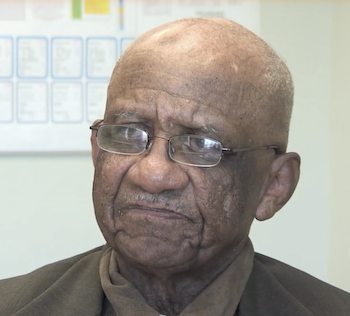Scientist, inventor, and activist William Conan Davis, the first African American to earn a doctorate from the University of Idaho, was born on August 22, 1926, in Waycross, Georgia. His father, Kince Charles Davis, was an Ethiopian Jew and a railway construction engineer, and his mother was Laura Jane Cooper. His siblings included the legendary actor and civil rights activist Ossie Davis as well as Essie Davis Morgan, Kenneth Davis, and James Davis.
William Davis’s education began at the segregated Magnolia Grammar School in Waycross, but he graduated from Dasher High School in Valdosta, Georgia, in 1944. He left Georgia for New York City to pursue a college preparatory education at Dwight High School, graduating in 1945. He continued at the City College of New York and later transferred to Talladega College in Alabama. There he was a U.S. Army Reserve Officers’ Training Corps member and was commissioned as a Second Lieutenant in the U.S. Army Corps of Engineers. Davis served in the Korean War and was awarded a Purple Heart in 1953.
Upon being honorably discharged in 1953, Davis returned to Talladega. He received a Bachelor of Arts in chemistry in 1956 with minors in mathematics, physics, and biology and was initiated into the Omega Psi Phi Fraternity, Inc.
From 1956 to 1958, Davis was a George Washington Carver-Ford research fellow at Tuskegee Institute. There he created instant mashed potatoes, soft-serve ice cream, and industrial glue. He also standardized medical tests for insulin and growth hormones. While at Tuskegee, he earned a Master of Science degree in organic chemistry in 1958.
In 1965, Davis earned a Doctor of Philosophy in Biochemistry and Organic Chemistry from the University of Idaho at Moscow, the only institution willing to accept him as a research-track graduate student. There he researched potato chips and what caused them to blister when fried, and he isolated the substance that caused the blistering. His dissertation topic was A Study of Sloughing in the Potato Tuber.
In 1970, Davis collaborated with the Portland Black Panther Party to establish a free medical clinic in the city’s Albina neighborhood that provided free healthcare to local Black people. From 1970 to 1979, he also served as the director of United Medical Laboratories in Portland, Oregon. He also pursued post-doctoral work in solid-phase immunoassays at the George Hyman Research Institute in Washington, DC.
From 1979 to 1982, Davis was research associate in molecular pharmacology at the University of Texas Health Science Center at San Antonio. In 1983, he became a chemistry professor at St. Philip’s College in San Antonio and served as chair of its Department of Natural Sciences from 1996 until his retirement in 2009. There, he helped establish the Ernest Stevenson Collection of scientific books and artifacts housed at the Sutton Learning Center. The following year, in 2010, St. Philip’s College awarded him an Honorary associate degree. Two years later, in 2012, the college science building was named the William C. Davis Science Building.
Davis was inducted into the Texas Science Hall of Fame and received the Liberty Science Center’s Genius Award in 2020.
William was married to Ocia Jenkins Davis. They had two children, Cheryl Elise Davis and Mark Alan Davis. Dr. William Conan Davis died in San Antonio, Texas, on March 16, 2022, at the age of 96.
Do you find this information helpful? A small donation would help us keep this available to all. Forego a bottle of soda and donate its cost to us for the information you just learned, and feel good about helping to make it available to everyone.
BlackPast.org is a 501(c)(3) non-profit and our EIN is 26-1625373. Your donation is fully tax-deductible.
“Dr. William Conan Davis,” https://www.alamo.edu/; “Dr. William Conan Davis, Biochemist born,” https://aaregistry.org/; “SPC Professor Emeritus, Dr. William C. Davis, Hailed as a “Genius” by the Liberty Science Center,” https://www.alamo.edu/.

